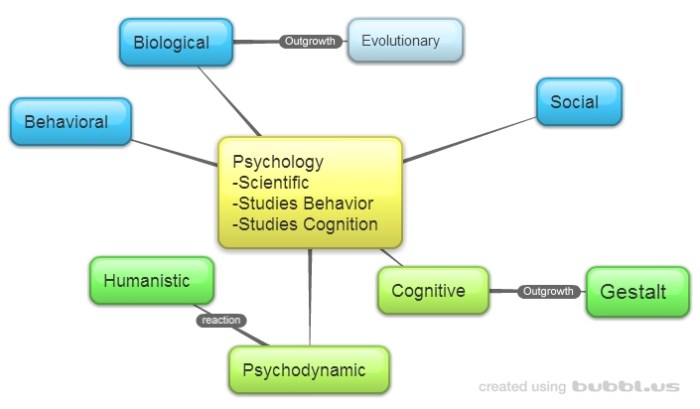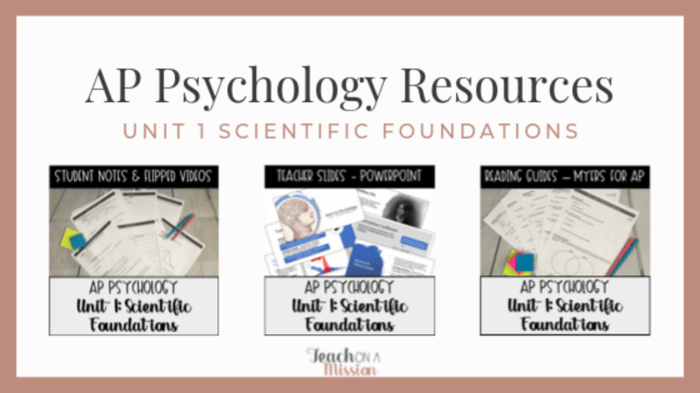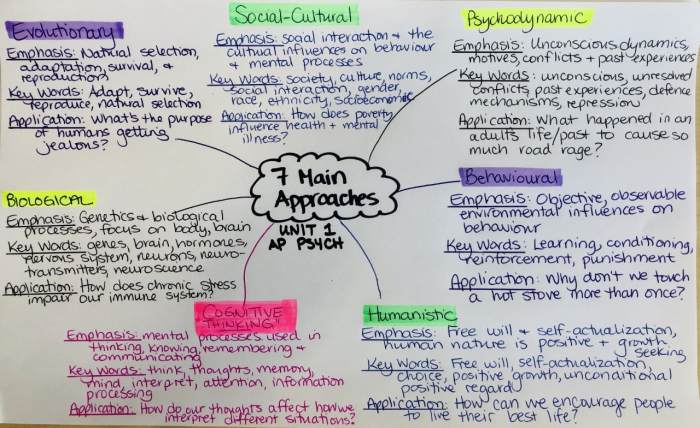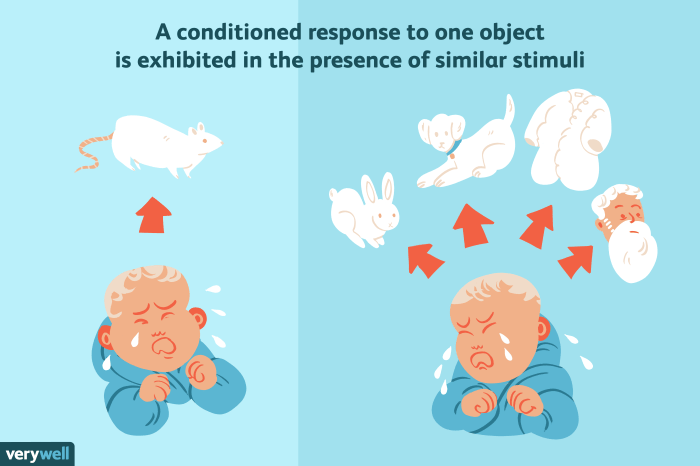AP Psychology Unit 1 Terms: Delve into the fascinating world of psychology, where we explore the historical foundations, research methods, and biological bases of behavior. Join us on an intellectual journey as we unravel the complexities of the human mind and gain a deeper understanding of ourselves and others.
Historical Foundations of Psychology
Psychology emerged as a scientific discipline in the late 19th century, with the establishment of the first psychology laboratory by Wilhelm Wundt in 1879. Wundt’s approach, known as structuralism, focused on breaking down mental processes into their basic elements. This method laid the foundation for experimental psychology and the scientific study of the mind.
Structuralism and Functionalism, Ap psychology unit 1 terms
Structuralism’s emphasis on the structure of the mind was challenged by functionalism, a school of thought led by William James. Functionalists argued that the mind should be studied in terms of its function, or how it helps organisms adapt to their environment.
This perspective shifted the focus of psychology from the mind’s structure to its purpose.
Behaviorism and Humanism
In the early 20th century, behaviorism emerged as a dominant force in psychology. Behaviorists, such as John B. Watson and B.F. Skinner, believed that psychology should only study observable behaviors, rather than internal mental processes. This approach led to a focus on stimulus-response relationships and the use of conditioning techniques.In
contrast to behaviorism, humanism emerged in the mid-20th century as a reaction to the perceived limitations of behaviorism. Humanists, such as Carl Rogers and Abraham Maslow, emphasized the importance of free will, personal growth, and subjective experiences. This perspective broadened the scope of psychology to include the study of human potential and well-being.
Research Methods in Psychology

Research is the backbone of psychology, allowing us to understand the complexities of the human mind and behavior. The scientific method provides a systematic framework for conducting psychological research, ensuring objectivity and reliability.
The Scientific Method
- Observation:Identifying a problem or phenomenon to investigate.
- Hypothesis:Formulating a testable prediction about the relationship between variables.
- Experimentation:Designing and conducting a study to test the hypothesis.
- Data Collection:Gathering information relevant to the hypothesis.
- Data Analysis:Interpreting and analyzing the data to determine if it supports the hypothesis.
- Conclusion:Drawing inferences and making generalizations based on the results.
Qualitative vs. Quantitative Research Methods
Qualitative methodsfocus on gathering in-depth, subjective data through techniques like interviews, observations, and case studies. They provide rich insights into individual experiences and perspectives.
Quantitative methodsinvolve collecting numerical data through surveys, experiments, and other statistical techniques. They allow for statistical analysis and generalization to larger populations.
Ethical Principles in Psychological Research
Ethical guidelines ensure that research is conducted responsibly and protects participants’ rights and well-being. These principles include:
- Informed consent:Participants must fully understand and voluntarily agree to participate.
- Confidentiality:Participant data must be kept private and anonymous.
- Beneficence:Research should minimize potential harm and maximize potential benefits.
- Justice:Participants should be treated fairly and equitably.
Biological Bases of Behavior

The biological bases of behavior encompass the intricate interplay between the nervous system, neurotransmitters, and brain activity. Understanding these components provides a foundation for comprehending the physiological underpinnings of psychological processes.
Structure and Function of the Nervous System
The nervous system, composed of the brain, spinal cord, and peripheral nerves, serves as the body’s primary communication network. It receives sensory information from the environment, processes it, and triggers appropriate responses. The nervous system can be broadly classified into two divisions: the central nervous system (CNS) and the peripheral nervous system (PNS).
The CNS comprises the brain and spinal cord, while the PNS includes all other nerves that extend from the CNS to the rest of the body.The brain, the control center of the nervous system, is responsible for higher-order functions such as cognition, emotion, and memory.
It is divided into two hemispheres, each controlling the opposite side of the body. The spinal cord, a long, cylindrical structure located within the vertebral column, serves as a relay center for sensory and motor information between the brain and the rest of the body.The
PNS consists of somatic and autonomic divisions. The somatic division controls voluntary movements, while the autonomic division regulates involuntary functions such as heart rate, digestion, and breathing. The autonomic division is further divided into the sympathetic and parasympathetic systems, which work in opposition to maintain homeostasis.
Role of Neurotransmitters in Psychological Processes
Neurotransmitters are chemical messengers that facilitate communication between neurons. They are released from the presynaptic neuron into the synaptic cleft, where they bind to receptors on the postsynaptic neuron, triggering an electrical or chemical response.There are numerous neurotransmitters, each with distinct roles in psychological processes.
Some key neurotransmitters include:
- Dopamine:Associated with reward, motivation, and pleasure.
- Serotonin:Involved in mood regulation, sleep, and appetite.
- Norepinephrine:Plays a role in attention, arousal, and mood.
- GABA (gamma-aminobutyric acid):Has inhibitory effects on the nervous system, promoting relaxation and sleep.
- Glutamate:The most abundant neurotransmitter in the brain, involved in learning, memory, and cognition.
Imbalances in neurotransmitter levels have been linked to various psychological disorders. For example, low levels of serotonin are associated with depression, while excessive dopamine activity is implicated in schizophrenia.
Relationship between Brain Activity and Behavior
Brain activity, measured through techniques such as electroencephalography (EEG) and functional magnetic resonance imaging (fMRI), provides insights into the neural correlates of behavior. By observing changes in brain activity, researchers can identify the specific brain regions involved in different psychological processes.For
instance, studies have shown that the prefrontal cortex is involved in higher-order cognitive functions such as planning, decision-making, and working memory. The amygdala, on the other hand, is associated with processing emotions, particularly fear and anxiety.Understanding the relationship between brain activity and behavior allows for a deeper comprehension of the biological underpinnings of psychological processes.
It also has implications for the development of treatments for psychological disorders, as interventions can be tailored to target specific brain regions and neurotransmitter systems.
Sensation and Perception

Sensation and perception are two distinct but related processes that allow us to experience and understand the world around us. Sensation refers to the detection of physical stimuli by our sensory receptors, while perception is the interpretation of those sensations and the organization of them into meaningful experiences.
The Five Senses
We have five primary senses that contribute to our perception of the world: sight, hearing, smell, taste, and touch. Each sense is specialized for detecting a particular type of physical stimulus. For example, our eyes are sensitive to light waves, our ears to sound waves, our nose to chemical molecules, our tongue to dissolved substances, and our skin to pressure, temperature, and pain.
Attention and Cognitive Processes
Perception is not simply a passive process of receiving sensory information. Our attention and cognitive processes play an active role in shaping our perception of the world. Attention allows us to focus on specific stimuli and ignore others, while cognitive processes help us to interpret and organize sensory information into meaningful experiences.
States of Consciousness
Consciousness refers to our subjective experience of the world around us and our own thoughts, feelings, and memories. It exists on a continuum, ranging from full alertness to deep sleep.
Levels of Consciousness
There are different levels of consciousness, including:
- Awake and Alert:Fully aware of surroundings and able to respond appropriately.
- Daydreaming:Attention wanders and thoughts become less focused.
- Hypnosis:Trance-like state where attention is highly focused and suggestible.
- Sleep:Characterized by reduced awareness and responsiveness to stimuli.
- Coma:Unresponsive state with no awareness of surroundings.
Sleep and Dreams
Sleep is crucial for physical and psychological well-being. It consists of two main types: rapid eye movement (REM) sleep and non-rapid eye movement (NREM) sleep.
Dreams occur during REM sleep and are thought to play a role in memory consolidation, emotional processing, and creativity.
Drugs and Consciousness
Drugs and other substances can alter consciousness by affecting brain chemistry. Some drugs, like caffeine, can stimulate alertness, while others, like alcohol, can depress it.
Substance abuse can lead to addiction and severe consequences for mental and physical health.
Learning
Learning is the process of acquiring new knowledge, skills, behaviors, or values. It involves changes in our cognitive structures and behaviors, allowing us to adapt to new situations and experiences.There are several types of learning, each with its unique characteristics and processes:
Classical Conditioning
In classical conditioning, a neutral stimulus (e.g., a bell) is paired with a meaningful stimulus (e.g., food) to elicit a conditioned response (e.g., salivation).
Operant Conditioning
Operant conditioning involves learning through the consequences of our actions. Positive reinforcement (e.g., praise) increases the likelihood of repeating a behavior, while negative reinforcement (e.g., removing an unpleasant stimulus) decreases the likelihood. Punishment, on the other hand, decreases the likelihood of repeating a behavior.
Observational Learning
Observational learning, also known as social learning, occurs when we learn by observing the behavior of others and the consequences they experience.
Cognitive Processes in Learning
Cognitive processes play a crucial role in learning, including:
Attention
Focusing on relevant information and ignoring distractions.
Memory
Storing and retrieving information.
Problem-solving
Applying knowledge and skills to solve problems.
Metacognition
Thinking about our own thinking and learning strategies.
Memory
Memory refers to the ability of the mind to encode, store, and retrieve information. It encompasses various types, each with distinct functions: Sensory MemoryHolds sensory information briefly (less than a second) after it is received.
Examples
Iconic memory (visual) and echoic memory (auditory).
Short-Term Memory (STM)
- Stores information for a short period (up to 20 seconds).
- Limited capacity (7±2 items).
- Forgets information quickly unless rehearsed.
Long-Term Memory (LTM)
- Stores information for an extended period (days, weeks, years).
- Unlimited capacity.
Subdivided into
– Episodic Memory: Stores personal experiences. – Semantic Memory: Stores general knowledge and facts. – Procedural Memory: Stores motor skills and habits. Working MemoryTemporary storage and manipulation of information.
-
Capacity
Limited (7±2 items).
- Plays a crucial role in reasoning, problem-solving, and language comprehension.
Encoding
The process of transforming information into a form that can be stored in memory. Types include:
Acoustic Encoding
Storing information based on its sound.
Visual Encoding
Storing information based on its appearance.
Semantic Encoding
Storing information based on its meaning.
Storage
The process of retaining encoded information in memory over time. Types include:
Short-Term Storage
Temporary storage of information in STM.
Long-Term Storage
Permanent storage of information in LTM.
Retrieval
The process of accessing and recovering stored information from memory. Types include:
Recall
Retrieving information without cues.
Recognition
Identifying information when presented with cues.
Factors Affecting Memory Accuracy
Encoding
Depth of processing, organization, and rehearsal.
Storage
Consolidation, interference, and decay.
Retrieval
Retrieval cues, retrieval strategies, and emotional state.
Cognition: Ap Psychology Unit 1 Terms
Cognition refers to the mental processes involved in acquiring, storing, retrieving, and using knowledge. It encompasses a wide range of abilities, including attention, problem-solving, decision-making, memory, language, and perception. Cognitive processes enable us to interact with our environment, learn from experiences, and make informed decisions.
Attention
Attention is the process of selectively focusing on specific stimuli while ignoring others. It allows us to prioritize information, allocate mental resources, and respond appropriately to our surroundings. Attention is crucial for learning, problem-solving, and everyday activities.
Problem-Solving
Problem-solving involves finding solutions to challenges or obstacles. It requires cognitive processes such as identifying the problem, generating possible solutions, evaluating their feasibility, and implementing the best course of action. Effective problem-solving skills are essential for navigating complex situations and achieving goals.
Decision-Making
Decision-making is the process of selecting a course of action from a set of alternatives. It involves evaluating the potential outcomes of each option, considering the available information, and weighing the pros and cons. Cognitive biases, such as confirmation bias and availability heuristic, can influence decision-making and lead to suboptimal choices.
Cognitive Biases
Cognitive biases are systematic errors in thinking that can lead to irrational or inaccurate judgments. They are caused by limitations in our cognitive processing and can impact our decision-making, problem-solving, and perception. Understanding cognitive biases can help us make more informed and objective choices.
Motivation and Emotion

Motivation is the driving force behind our actions and behaviors. It determines what we want, why we want it, and how we go about achieving it. Emotion, on the other hand, refers to our subjective experiences of feelings, such as joy, sadness, anger, and fear.
Both motivation and emotion play crucial roles in our psychological well-being and overall functioning.
Theories of Motivation
There are several different theories that attempt to explain motivation. Some of the most prominent theories include:
- Drive theory: This theory suggests that motivation is driven by internal physiological needs, such as hunger, thirst, and sleep.
- Incentive theory: This theory suggests that motivation is driven by external rewards or punishments.
- Cognitive theory: This theory suggests that motivation is driven by our thoughts, beliefs, and expectations.
Role of Emotions in Psychological Well-being
Emotions play a vital role in our psychological well-being. Positive emotions, such as joy, happiness, and love, can promote physical and mental health. Negative emotions, such as sadness, anger, and fear, can have negative consequences for our well-being if they are not managed effectively.
Relationship between Motivation and Emotion
Motivation and emotion are closely related. Our emotions can influence our motivation, and our motivation can influence our emotions. For example, if we are feeling motivated to achieve a goal, we are more likely to experience positive emotions, such as excitement and anticipation.
Conversely, if we are feeling unmotivated, we are more likely to experience negative emotions, such as boredom and frustration.
Development Across the Lifespan

Development across the lifespan refers to the physical, cognitive, and social-emotional changes that occur throughout an individual’s life. These changes are influenced by a complex interplay of biological, environmental, and cultural factors.
AP Psychology Unit 1 terms lay the groundwork for understanding the field, including concepts like research methods and ethics. One significant historical event that highlights these principles is the Mier y Terán report , which sparked discussions on the ethical implications of research involving human subjects.
By studying such cases, we can better appreciate the importance of ethical considerations in psychological research and apply these principles in our own studies of AP Psychology Unit 1 terms.
Physical Development
Physical development involves changes in an individual’s physical characteristics, such as height, weight, body composition, and motor skills. These changes occur rapidly during infancy and childhood, gradually slow down during adolescence, and continue at a slower pace throughout adulthood.
Cognitive Development
Cognitive development involves changes in an individual’s mental abilities, such as intelligence, memory, attention, and problem-solving skills. These changes occur gradually throughout childhood and adolescence, and continue to develop in adulthood, although at a slower pace.
Social-Emotional Development
Social-emotional development involves changes in an individual’s ability to interact with others, understand their emotions, and develop a sense of self. These changes occur rapidly during infancy and childhood, gradually slow down during adolescence, and continue to develop in adulthood.
Theories of Development
Various theories attempt to explain the mechanisms underlying developmental changes. These include:
- Piaget’s Cognitive Development Theory
- Erikson’s Psychosocial Development Theory
- Vygotsky’s Sociocultural Theory
- Bronfenbrenner’s Bioecological Model
Challenges and Opportunities
Individuals face different challenges and opportunities at different stages of life. These include:
- Infancy and Childhood:Establishing a sense of security, developing motor skills, and learning language.
- Adolescence:Navigating physical and emotional changes, developing independence, and establishing an identity.
- Adulthood:Balancing career, family, and personal responsibilities, and coping with the challenges of aging.
Personality
Personality refers to the enduring patterns of thoughts, feelings, and behaviors that characterize an individual. It encompasses our unique traits, motivations, and values that shape our interactions with the world.
Theories of Personality
There are numerous theories that attempt to explain the development and structure of personality. Some prominent theories include:
- Psychoanalytic Theory:Emphasizes the role of unconscious processes, childhood experiences, and defense mechanisms in shaping personality.
- Behavioral Theory:Focuses on the role of learning and conditioning in shaping behavior and personality.
- Humanistic Theory:Stresses the importance of free will, self-actualization, and personal growth.
- Trait Theory:Proposes that personality is composed of a set of stable and measurable traits that determine behavior.
Role of Genetics, Environment, and Culture
Personality is influenced by a complex interplay of genetics, environment, and culture.
- Genetics:Inherited traits can influence temperament and certain personality characteristics.
- Environment:Early experiences, parenting style, and social interactions shape personality development.
- Culture:Cultural norms, values, and expectations influence the development of personality traits.
Assessment and Measurement of Personality
Personality can be assessed and measured using various methods, including:
- Self-Report Inventories:Questionnaires where individuals report on their own thoughts, feelings, and behaviors.
- Observational Methods:Trained observers assess behavior and personality traits through direct observation.
- Projective Tests:Tests that use ambiguous stimuli to elicit responses that reveal unconscious thoughts and feelings.
Psychological Disorders
Psychological disorders are characterized by significant disturbances in thoughts, feelings, and behavior that cause distress or impairment in functioning. They can manifest in a wide range of symptoms and can affect people of all ages, backgrounds, and cultures.
The causes of psychological disorders are complex and can include genetic, biological, environmental, and social factors. Some disorders, such as anxiety disorders, are thought to be caused by a combination of genetics and life experiences. Others, such as schizophrenia, are thought to be caused by a combination of genetic and environmental factors.
Types of Disorders
- Anxiety disordersare characterized by excessive fear, worry, and anxiety. They include conditions such as generalized anxiety disorder, panic disorder, and social anxiety disorder.
- Mood disordersare characterized by disturbances in mood, such as depression and bipolar disorder.
- Psychotic disordersare characterized by a loss of contact with reality, such as schizophrenia.
- Personality disordersare characterized by inflexible and unhealthy personality traits that cause distress or impairment in functioning.
- Eating disordersare characterized by disturbances in eating habits, such as anorexia nervosa and bulimia nervosa.
- Substance use disordersare characterized by compulsive use of drugs or alcohol.
Treatment Options
The treatment of psychological disorders depends on the specific disorder and the individual patient. Some common treatment options include:
- Psychotherapyinvolves talking to a therapist about your thoughts, feelings, and behaviors.
- Medicationcan be used to treat symptoms of psychological disorders, such as anxiety or depression.
- Lifestyle changes, such as exercise, healthy eating, and sleep, can help improve mental health.
Social Psychology

Social psychology is the scientific study of how individuals think, feel, and behave in social situations. It explores how our interactions with others shape our thoughts, emotions, and actions. Social psychology encompasses a wide range of research areas, including:
- Interpersonal relationships
- Social cognition
- Social influence
- Group dynamics
- Cultural psychology
Social Influence
Social influence refers to the ways in which our thoughts, feelings, and behaviors are affected by others. This can take many forms, including:
Conformity
Changing our behavior to match the behavior of others.
Obedience
Complying with the demands of an authority figure.
Persuasion
Changing our attitudes or beliefs as a result of exposure to a persuasive message.
Culture and Social Norms
Culture is a system of shared beliefs, values, and practices that shape our thoughts, feelings, and behaviors. Social norms are unwritten rules that dictate what is considered acceptable and unacceptable behavior within a particular culture. Both culture and social norms have a profound impact on our psychological processes, including our perception, memory, and motivation.
Applications of Psychology
Psychology has a wide range of applications in various fields, each focusing on specific aspects of human behavior and well-being. These applied fields include clinical psychology, educational psychology, and industrial-organizational psychology.
Clinical psychology involves the assessment, diagnosis, and treatment of mental health disorders. Clinical psychologists work with individuals and groups to help them manage their mental health conditions and improve their overall well-being.
Educational psychology focuses on the learning process and how to improve educational outcomes. Educational psychologists work with students, teachers, and parents to develop effective teaching methods, assess learning styles, and create supportive learning environments.
Industrial-organizational psychology applies psychological principles to the workplace. Industrial-organizational psychologists work with businesses and organizations to improve employee productivity, job satisfaction, and overall organizational effectiveness.
Ethical Considerations
The application of psychology in various fields raises important ethical considerations. Psychologists must adhere to ethical guidelines and principles to ensure the responsible and ethical use of psychological knowledge and techniques. These guidelines include maintaining confidentiality, obtaining informed consent, and avoiding harm to participants.
FAQ Explained
What are the key historical foundations of psychology?
Wilhelm Wundt’s establishment of the first psychology laboratory, structuralism and functionalism, behaviorism, and humanism.
What are the main research methods used in psychology?
Scientific method, qualitative and quantitative methods, ethical principles.
How does the nervous system contribute to psychological processes?
Structure and function of the nervous system, role of neurotransmitters, relationship between brain activity and behavior.